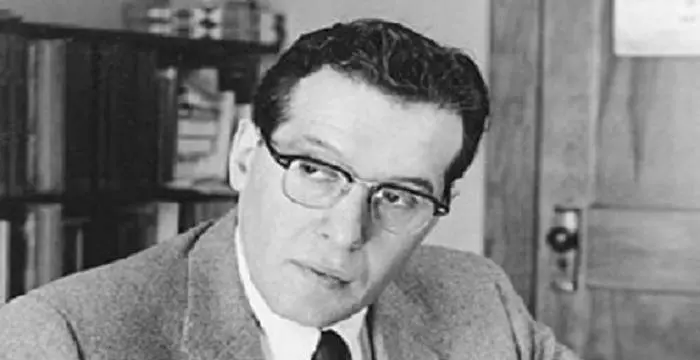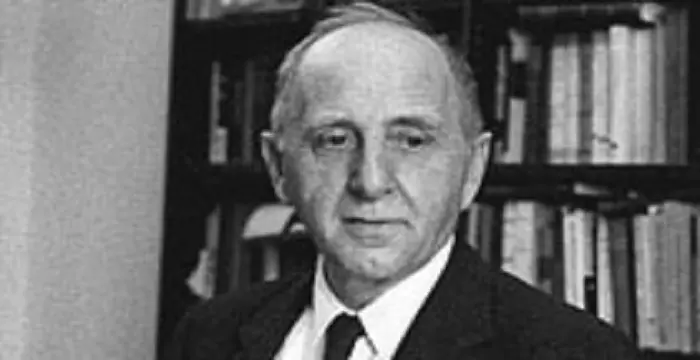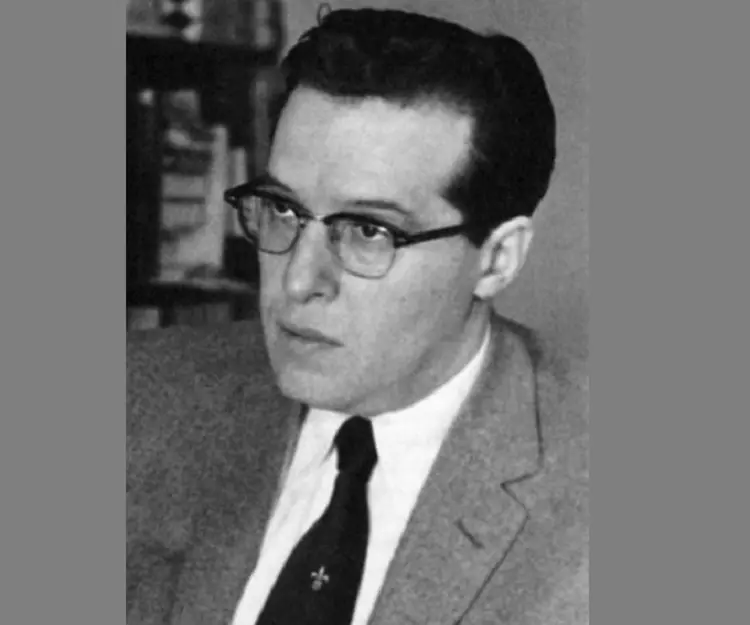
Julian Schwinger - Columbia University, Facts and Facts
Julian Schwinger's Personal Details
Julian Seymour Schwinger was an American theoretical physicist who won the Nobel Prize in Physics in 1965
| Information | Detail |
|---|---|
| Birthday | February 12, 1918 |
| Died on | July 16, 1994 |
| Nationality | American |
| Famous | Columbia University, Scientists, Physicists |
| Known as | Julian Seymour Schwinger |
| Universities |
|
| Notable Alumnis |
|
| Birth Place | New York City |
| Gender | Male |
| Sun Sign | Aquarius |
| Born in | New York City |
| Famous as | Physicist |
| Died at Age | 76 |
// Famous Columbia University
Helen Morris
Helen Morris is a former book editor, TV producer and the wife of Academy Award winning director Martin Scorsese. Check out this biography to know about her birthday, childhood, family life, achievements and fun facts about her.
Simon Kuznets
Simon Kuznets was a noted Russian-American economist, statistician, demographer, and economic historian. Check out this biography to know about his childhood, family life, achievements and other facts related to his life.
Anna Paquin
Anna Paquin is a Kiwi film, theatre and television actress known for her roles in movies like ‘The Piano’, ‘Fly Away Home’, and ‘X-Men. This biography provides detailed information about her childhood, life, achievements, works & timeline.
Julian Schwinger's photo
Who is Julian Schwinger?
Julian Seymour Schwinger was an American theoretical physicist who won the Nobel Prize in Physics in 1965 for his fundamental work in quantum electrodynamics. His fascination for physics grew while going through Encyclopedia Britannica at a very young age. Very soon he began to visit public libraries and read outside books on that subject. By the age of sixteen he had published his first paper on physics. However, his penchant for higher knowledge almost ruined his college education. It was Professor Isidor Isaac Rabi of Columbia University, who first recognized his talent and took him under his wings. Under his guidance, Schwinger not only earned his B.S. degree, but also his PhD. Very soon, he established himself as a brilliant theorist. However, he was fiercely independent and did not accept interference in his work. That is why he mostly worked at night. Although he dealt in diverse branches of physics, his works on quantum electrodynamics is specially noted. However, many believe that his students were his most enduring achievements. He left more than seventy students, through whom he continued to influence modern physics long after his death.
// Famous Scientists
Juliane Koepcke
Juliane Koepcke is a German-Peruvian biologist, who was the lone survivor among the 92 passengers and crew of the ill-fated LANSA Flight 508 that crashed in the Peruvian rainforest on 24 December 1971. Know more about her life in this biography.
Henry Cavendish
Henry Cavendish was a theoretical chemist and physicist, renowned for discovery of hydrogen and calculation of the mass of earth. To know more about his childhood, profile, timeline and career read on
Konstantin Tsiolkovsky
Konstantin Tsiolkovsky was a Russian rocket scientist and a pioneer of astronautics. This biography provides detailed information about his childhood, family, personal life, career, achievements, etc.
Childhood & Early Life
Julian Seymour Schwinger was born on February 12, 1918, in New York City in a well to do Jewish family. His father, Benjamin Schwinger, was a successful clothing manufacturer. His mother’s name was Belle (née Rosenfeld) Schwinger.
Julian had an elder brother named Harold. Both the children were enrolled at Townsend Harris High School for their secondary education. Born a child progeny, Julian became interested in physics at an early age.
He later said that he had been reading Encyclopedia Britannica at home and got stuck when he reached ‘Physics’. Soon he began to visit public libraries to gain additional knowledge in that subject. In fact, most of his knowledge of physics at that time was gathered outside the formal educational system.
After passing out from school in 1933, Julian first entered the City College of New York with physics as his major. By this time he had formed the habit of studying at night. More than his text books, he kept reading outside publications and thus gained in depth knowledge on the subject.
Julian published his first paper in physics in 1934 at the age of sixteen and by the age of seventeen he was doing advanced calculations. Yet, because he did not attend classes and were more interested in solving higher problems, he began to have difficulties with his instructors and started failing in examinations.
Fortunately for him, one of his letters published in the ‘Letters to the Editor’ section in ‘Physical Review’ caught the attention of Professor Isidor Isaac Rabi of Columbia University. He was more impressed when he met young Julian face to face.
On Rabi’s advice, Julian left City College of New York and joined University of Columbia. He received his B.S. degree from the University of Columbia in 1936. By this time, he had started working on a paper titled ‘Magnetic Scattering of Neutrons’ and once completed, submitted it to the ‘Physical Review’.
The paper caught the attention of renowned theoretical physicists Edward Teller. On his advice, Julian developed the thesis further and submitted it as his PhD dissertation. However, he did not immediately get his degree.
At that time, it was mandatory for doctoral students to attend mathematics classes, which Julian had failed to do, mainly because those classes were held in early morning. To compensate that, he had to sit for an examination.
The mathematics professor, on the advice of Isidor Isaac Rabi, set up an extraordinary tough paper. In spite of that, Julian passed out with flying colors and received his doctoral degree in 1939. He was only twenty-one years old then.
Career
After receiving his PhD in 1939, Julian Schwinger joined University of California, Berkeley as National Research Council Fellow. Next year in 1940, he began to work as the research associate of J Robert Oppenheimer.
He received his regular academic appointment in the summer of 1941 as an instructor of physics at the Purdue University, Indiana. The following year he was promoted to the post of Assistant Professor at the same University.
At that time, an active program in semiconductor research was being carried out at Purdue for the Radiation Laboratory of the Massachusetts Institute of Technology. Schwinger joined the program in 1942 and worked on the propagation of microwave radiation in microwave cavities.
In the beginning of 1943, Oppenheimer asked Schwinger to join him at Los Alamos National Laboratory, where an atomic bomb was being built. Schwinger refused; instead he joined the Radiation Laboratory at MIT later in the same year.
Being a night bird and a loner, Schwinger chose to become a night research staff. This allowed him to work in solitude. By applying his knowledge of nuclear physics on electromagnetic engineering, he arrived at the theory of nuclear scattering, which ultimately provided important inputs in the design of radars.
While working at Radiation Laboratory, he also solved a wide variety of microwave problems. The results of these works were later used by him to formulate many of his famous theories. At the same time, he gave a number of lectures on wave guides. These were attended by a selected group of colleagues.
His lectures during this period exhibited his astounding analytical power as well as his depth of knowledge in varied branches of science. However, the war ended before, he could finish the series. Much later in 1968, these lectures were compiled in a book called ‘Discontinuities in Waveguides’
As the war ended in 1945, Schwinger received offers from many established universities. Ultimately, he left Purdue to join Harvard University as an Associate Professor and remained there until 1972.
In 1947, he was promoted to the post of full professor. In the same year in September, Schwinger developed the concept of renormalization, which was able to explain the phenomenon called Lamb Shift in the magnetic field of an electron.
During his tenure at Harvard, Schwinger worked on various aspects of modern theoretical physics and until mid 1950s, was considered an authority on that subject. In 1948-1949, he submitted a series of papers titled ‘Quantum Electrodynamics’ (Parts I, II, and III) to ‘Physics Review’, which earned him great acclaim.
In 1951, he presented his formulation of the equations for the Green’s functions of quantum fields in Proceedings of the National Academy of Sciences. He also gave many innovative lectures, which contained many new results. Although he did not bother to publish many of them, some were later printed by his students.
From the middle of 1950s, some of his theories began to be challenged. Nonetheless, he continued exploring new paths and from 1966, he began to develop his ‘source theory’, which was a reformulation of quantum electrodynamics theory. However, the theory was not accepted by many of colleagues at Harvard.
In 1972, Schwinger left Harvard to join University of California, Los Angeles. There he continued with his work on source theory, which according to him was the mathematical symbolism of human manipulations in high-energy physics.
Starting in the 1980s, Schwinger began a series of papers on the Thomas-Fermi model of atoms. Then from 1989, he began to take interest in the non-mainstream research of cold fusion. However, his papers were not accepted for publications. His last published paper was on sonoluminescence.
All through his working life, Schwinger had published around 200 papers and had penned number of books. He also acted as academic advisor to around 73 doctoral students and 20 post doctoral students. Many of them had later become well known physicists and three of them had won Nobel Prize. Through them his theories continue to influence modern physics.
Major Works
Julian Schwinger is best known for his work on quantum electrodynamics (QED). He not only developed the formalism of the new QED in several fundamental papers, but had also made them more useful for practical calculations. His findings helped to bring about new dimension to the quantum field theory.
Awards & Achievements
Julian Schwinger shared the 1965 Nobel Prize in Physics along with Richard Feynman and Shinichiro Tomonaga. Although three of them worked separately, their fundamental work in quantum electro dynamics injected new ideas in the field of QED, which had far reaching consequences.
Other than the Nobel Prize, Schwinger also received the Nature of Light Award of the U.S. National Academy of Sciences in 1949, Albert Einstein Award in 1951 and the U.S. National Medal of Science in 1964.
He also received honorary D.Sc. degrees from Purdue University in 1961 and from Harvard University in 1962.
Personal Life & Legacy
Julian Schwinger married Clarice Carrol in 1947 while he was teaching at the Harvard University. The couple did not have any children.
Towards the end of his life, Schwinger was afflicted with pancreatic cancer. In spite of that, he worked intensely almost till the last. His last paper (on sonoluminescence) was published in the very year of his death.
He died from pancreatic cancer on July 16, 1994 at his home in Los Angeles. He was survived by his wife Clarice.
Trivia
He wrote his PhD dissertation while he was still an undergraduate student.
His career spanned for sixty years and during this period he had guided at least four generations of graduate students. According to Professor Saxon, the faculties of America's best universities are filled by Schwinger’s students and their students.
// Famous Physicists
Henry Cavendish
Henry Cavendish was a theoretical chemist and physicist, renowned for discovery of hydrogen and calculation of the mass of earth. To know more about his childhood, profile, timeline and career read on
Walter Kohn
Nobel Laureate Walter Kohn was an Austrian-born American theoretical chemist and physicist. Check out this biography to know about his childhood, life, achievements, works & timeline.
Nikola Tesla
Nikola Tesla was a Serbian-American inventor, best known for his development of alternating current electrical systems. This biography of Nikola Tesla provides detailed information about his childhood, life, achievements, works & timeline.
Julian Schwinger's awards
| Year | Name | Award |
|---|---|---|
Other | ||
| 0 | US & Canada | |
| 1965 | National Medal of Science for Physical Science | |
| 0 | 1965 - Nobel Prize in Physics | |
| 0 | 1951 - Albert Einstein Award | |
| 0 | 1970 - Guggenheim Fellowship for Natural Sciences | |
Julian Schwinger biography timelines
- // 12th Feb 1918Julian Seymour Schwinger was born on February 12, 1918, in New York City in a well to do Jewish family. His father, Benjamin Schwinger, was a successful clothing manufacturer. His mother’s name was Belle (née Rosenfeld) Schwinger.
- // 1933After passing out from school in 1933, Julian first entered the City College of New York with physics as his major. By this time he had formed the habit of studying at night. More than his text books, he kept reading outside publications and thus gained in depth knowledge on the subject.
- // 1934Julian published his first paper in physics in 1934 at the age of sixteen and by the age of seventeen he was doing advanced calculations. Yet, because he did not attend classes and were more interested in solving higher problems, he began to have difficulties with his instructors and started failing in examinations.
- // 1936On Rabi’s advice, Julian left City College of New York and joined University of Columbia. He received his B.S. degree from the University of Columbia in 1936. By this time, he had started working on a paper titled ‘Magnetic Scattering of Neutrons’ and once completed, submitted it to the ‘Physical Review’.
- // 1939The mathematics professor, on the advice of Isidor Isaac Rabi, set up an extraordinary tough paper. In spite of that, Julian passed out with flying colors and received his doctoral degree in 1939. He was only twenty-one years old then.
- // 1939 To 1940After receiving his PhD in 1939, Julian Schwinger joined University of California, Berkeley as National Research Council Fellow. Next year in 1940, he began to work as the research associate of J Robert Oppenheimer.
- // 1941He received his regular academic appointment in the summer of 1941 as an instructor of physics at the Purdue University, Indiana. The following year he was promoted to the post of Assistant Professor at the same University.
- // 1942At that time, an active program in semiconductor research was being carried out at Purdue for the Radiation Laboratory of the Massachusetts Institute of Technology. Schwinger joined the program in 1942 and worked on the propagation of microwave radiation in microwave cavities.
- // 1943In the beginning of 1943, Oppenheimer asked Schwinger to join him at Los Alamos National Laboratory, where an atomic bomb was being built. Schwinger refused; instead he joined the Radiation Laboratory at MIT later in the same year.
- // 1945 To 1972As the war ended in 1945, Schwinger received offers from many established universities. Ultimately, he left Purdue to join Harvard University as an Associate Professor and remained there until 1972.
- // 1947In 1947, he was promoted to the post of full professor. In the same year in September, Schwinger developed the concept of renormalization, which was able to explain the phenomenon called Lamb Shift in the magnetic field of an electron.
- // 1947Julian Schwinger married Clarice Carrol in 1947 while he was teaching at the Harvard University. The couple did not have any children.
- // 1948 To 1949During his tenure at Harvard, Schwinger worked on various aspects of modern theoretical physics and until mid 1950s, was considered an authority on that subject. In 1948-1949, he submitted a series of papers titled ‘Quantum Electrodynamics’ (Parts I, II, and III) to ‘Physics Review’, which earned him great acclaim.
- // 1949 To 1964Other than the Nobel Prize, Schwinger also received the Nature of Light Award of the U.S. National Academy of Sciences in 1949, Albert Einstein Award in 1951 and the U.S. National Medal of Science in 1964.
- // 1951In 1951, he presented his formulation of the equations for the Green’s functions of quantum fields in Proceedings of the National Academy of Sciences. He also gave many innovative lectures, which contained many new results. Although he did not bother to publish many of them, some were later printed by his students.
- // 1961 To 1962He also received honorary D.Sc. degrees from Purdue University in 1961 and from Harvard University in 1962.
- // 1965Julian Schwinger shared the 1965 Nobel Prize in Physics along with Richard Feynman and Shinichiro Tomonaga. Although three of them worked separately, their fundamental work in quantum electro dynamics injected new ideas in the field of QED, which had far reaching consequences.
- // 1966From the middle of 1950s, some of his theories began to be challenged. Nonetheless, he continued exploring new paths and from 1966, he began to develop his ‘source theory’, which was a reformulation of quantum electrodynamics theory. However, the theory was not accepted by many of colleagues at Harvard.
- // 1968His lectures during this period exhibited his astounding analytical power as well as his depth of knowledge in varied branches of science. However, the war ended before, he could finish the series. Much later in 1968, these lectures were compiled in a book called ‘Discontinuities in Waveguides’
- // 1972In 1972, Schwinger left Harvard to join University of California, Los Angeles. There he continued with his work on source theory, which according to him was the mathematical symbolism of human manipulations in high-energy physics.
- // 1989Starting in the 1980s, Schwinger began a series of papers on the Thomas-Fermi model of atoms. Then from 1989, he began to take interest in the non-mainstream research of cold fusion. However, his papers were not accepted for publications. His last published paper was on sonoluminescence.
- // 16th Jul 1994He died from pancreatic cancer on July 16, 1994 at his home in Los Angeles. He was survived by his wife Clarice.
// Famous Aquarius Celebrities peoples
Jessii Vee
Check out all that you wanted to know about Jessii Vee, the famous Canadian Vlogger & YouTube Personality; her birthday, her family and personal life, her boyfriends, fun trivia facts and more.
Luara Fonseca
Luara Fonseca, known on the web as “luaraff,” is a musical.ly star. Check out this biography to know about her childhood, family life, achievements and fun facts about her.
Shane Blanchard
Shane Blanchard is an American TV actor. Let’s take a look at his family and personal life including age, birthday, net worth, family life and some fun facts.
Nora Fatehi
Nora Fatehi is a dancer, model, and actress of Indo–Arabic descent. This biography profiles her childhood, family, personal life, etc.
Soni Nicole Bringas
Soni Nicole Bringas is an American dancer and actress. Let’s have a look at her family and personal life including age. Date of birth, boyfriends, net worth, and fun facts.
Davis Cleveland
Davis Cleveland is an American actor. Let’s have a look at his family & personal life including age, net worth, and fun facts.
Julian Schwinger's FAQ
What is Julian Schwinger birthday?
Julian Schwinger was born at 1918-02-12
When was Julian Schwinger died?
Julian Schwinger was died at 1994-07-16
Where was Julian Schwinger died?
Julian Schwinger was died in Los Angeles
Which age was Julian Schwinger died?
Julian Schwinger was died at age 76
Where is Julian Schwinger's birth place?
Julian Schwinger was born in New York City
What is Julian Schwinger nationalities?
Julian Schwinger's nationalities is American
What was Julian Schwinger universities?
Julian Schwinger studied at Columbia University, City College of New York, 1939 - Columbia University, Townsend Harris High School
What was Julian Schwinger notable alumnis?
Julian Schwinger's notable alumnis is Columbia University
What is Julian Schwinger's sun sign?
Julian Schwinger is Aquarius
How famous is Julian Schwinger?
Julian Schwinger is famouse as Physicist















